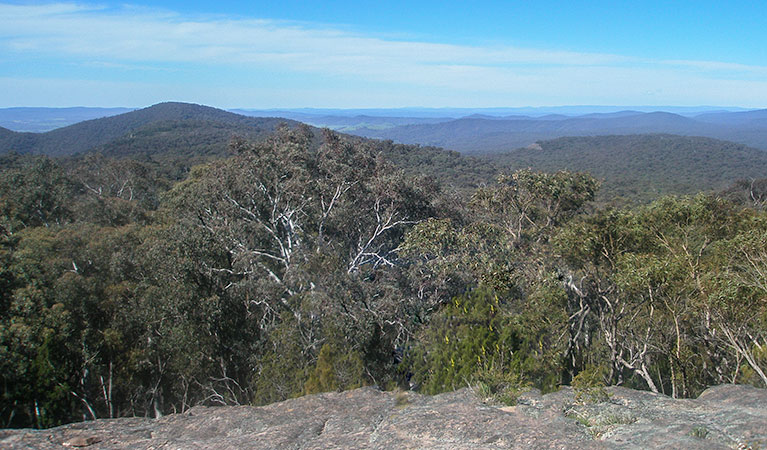Woomargama National Park
Overview
Woomargama National Park is the largest protected area of forest west of the Great Dividing Range. This place is great for camping, hiking and 4WD touring near Holbrook and Albury.
Read more about Woomargama National Park
It’s hardly a surprise that the vast expanse of Woomargama National Park is home to a large number of endangered species. Birdwatching reveals wonders such as the regent honeyeater, superb parrot and powerful owl.
If you’re camping here, then you can indulge in lots of wildlife watching. There are two campgrounds, both of which offer peace and quiet away from the fast-paced world. You're unlikely to have a more soothing picnic.
Hume and Hovell walking track cuts through Woomargama, so you can pick up its trail and go hiking through the bush. There are plenty of unsealed routes to test the capabilities of your 4WD or your cycling skills on a mountain bike. But you could just soak up the fresh air on foot, admire the multitude of wildflowers and enjoy the view. From Norths lookout, the vistas are among the most spectacular in the region.
Local alerts
For the latest updates on fires, closures and other alerts in this area, see https://www.nationalparks.nsw.gov.au/visit-a-park/parks/woomargama-national-park/local-alerts
Contact
- in the Murray-Riverina and Snowy Mountains regions
Woomargama National Park is always open but may have to close at times due to poor weather or fire danger.
-
-
Khancoban Visitor Centre
02 6070 8400
Contact hours: Winter (June to September): Open 9am to 4pm Monday to Friday and 10am to 2pm on weekends. Rest of year: Open 9am to 4pm daily. Closed Christmas Day. - 2 Scammel Street, Khancoban NSW 2642
-
Email: info.khancoban@environment.nsw.gov.au
-
Khancoban Visitor Centre
-
-
Tumut Region Visitor Centre
02 6947 7025
Contact hours: 9am to 5pm daily. Closed Christmas Day. - The Old Butter Factory, 5 Adelong Road, Tumut NSW 2720
-
Email: tumutrvc@environment.nsw.gov.au
-
Tumut Region Visitor Centre
Visitor info
All the practical information you need to know about Woomargama National Park.
Map

Map legend

Maps and downloads
Nearby towns
Holbrook (24 km)
During World War I, anti-German sentiment led to Germanton being renamed Holbrook, after British Navy Submarine Commander Norman Holbrook. Today, you can clamber all over the submarine HMAS Otway, which lies in parkland on the main road, and visit the Holbrook Submarine Museum.
Albury (56 km)
There are plenty of adventure experiences to enjoy around Albury-Wodonga. They include cycling, hiking and horse riding at Lake Hume, white-water rafting on the Upper Murray or a leisurely river cruise.
Wagga Wagga (103 km)
Wagga Wagga is renowned for its stunning parks and award-winning gardens. Take a tour through the 20 hectares of themed garden beds in the beautiful Wagga Wagga Botanic Gardens complete with mini zoo and free-flight aviary.
Learn more
Woomargama National Park is a special place. Here are just some of the reasons why:
Wild things

Some of the more common animals you'll see are echidnas, wombats, gliders, kangaroos and wallabies. These natives are best spotted in the early morning or late afternoon when they're most active. There are rare creatures too: listen for the 'ark' calls of the brown toadlet which lives in burrows or under rocks. Look upwards to catch a flash of colour as a bright green superb parrot flies overhead.
- Tunnel Road picnic area Located at the entrance to Woormagama National Park, near Holbrook, Tunnel Road picnic area is an idyllic spot where you can experience birdwatching, walking and wildflower displays in spring.
Tall timber

Situated in the transition zone between the mountainous NSW south-west slopes and the broad plains of the Riverina district, Woomargama has a vast range of forest and woodland communities. It contains the largest remnant community of box woodlands on the south-west slopes and is also home to the rare phantom wattle, which flowers golden yellow in spring.
- Norths Lookout Offering scenic views of Murray Valley, Snowy Mountains and Riverina, see Australian landscapes from Norths lookout, where you can picnic and relax.
Slice of history

Talk about an interesting past - Woomargama has just that. In 1924, explorers Hamilton Hume and William Hovell set off from Sydney to see if there was an overland route to Melbourne. While you're there, you'll appreciate how difficult their hiking must've been. Hume and Hovell walking track, a 440km bushwalking trail from Yass to Albury, almost directly follows their footsteps. Before it was named a national park, parts of Woomargama were mined for tin and used as grazing land.
Outstanding attractions

This wild landscape offers activities for all. Pitch a tent at one of the two campgrounds and use it as a base for exploring the surrounds. Pull on your hiking boots and hit the many trails that cross the park. They also offer a great ride if you fancy testing your limits on a mountain bike. It doesn't have to be quite so full-on though. There are many beautiful wildflowers and animals that are best observed quietly, and photographers will love the view from Norths lookout.
- Norths Lookout Offering scenic views of Murray Valley, Snowy Mountains and Riverina, see Australian landscapes from Norths lookout, where you can picnic and relax.
- Tunnel Road picnic area Located at the entrance to Woormagama National Park, near Holbrook, Tunnel Road picnic area is an idyllic spot where you can experience birdwatching, walking and wildflower displays in spring.
Education resources (1)
What we're doing
Woomargama National Park has management strategies in place to protect and conserve the values of this park. View the detailed park and fire management documents.

